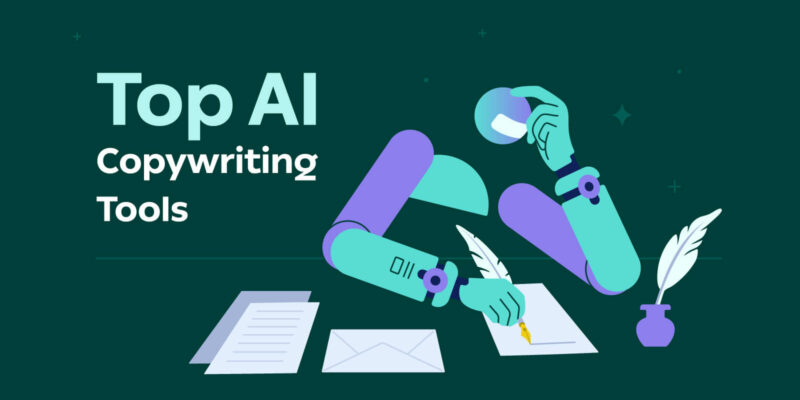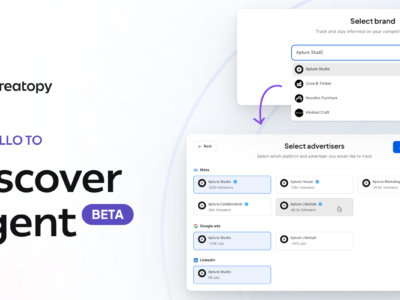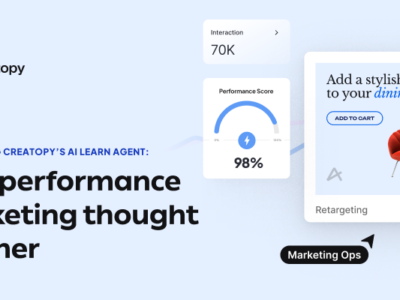When ChatGPT took the world by storm in 2022, most writers already (kind of) knew about AI copywriting tools. It’s no secret that OpenAI had been pushing natural language processing (NLP) technologies for years.
What changed, though, was the sheer mainstream explosion of interest. The technology finally crossed the threshold from “interesting experiment” to “practical tool,” and suddenly everyone from marketing managers to solo entrepreneurs wanted a piece of the action.
Fast forward to today, and the landscape has become almost impossibly crowded. It feels like there’s a new AI writing assistant launching every week, and they’re all making the same bold claims: “best-in-class,” “revolutionary,” “human-like writing in seconds.”
So, hype aside, how do you sift through all the information and narrow down your options to settle on an AI copywriting tool worth your money, time, energy, and copywriting genius?
In this comprehensive guide, we’ll help you navigate the increasingly complex world of AI writing tools and find the solution that truly fits your specific needs.
- What is AI copywriting?
- How can businesses use AI copywriting tools?
- Are there limitations to AI copywriting tools?
- How to choose an AI copywriting tool for your business?
- Industry-Specific AI Implementation Guides
- Ethical Considerations in AI-Generated Content
- Top 10 AI copywriting tools in 2025
- Frequently Asked Questions About AI Copywriting Tools
- The Future of AI in Copywriting: Trends to Watch
- AI in Copywriting: Finding the Right Balance
What Is AI Copywriting?
AI copywriting is the process of writing copy for ads, social media, emails, scripts, banners, and web pages using natural language processing and machine learning software.
To an untrained eye, AI copywriting might seem like no short of magic. But as any copywriter will tell you, writing effective copy is about (a lot) more than stringing words together. So while AI copywriting software can definitely save you time and energy, it’s not meant to be a replacement for human writers, but an assistant to help them be more productive (and focus on the actual creative elements of their work).
This is why AI copywriting tools are best viewed not as replacements for human writers, but as productivity partners that help professionals work more efficiently. They’re like having a tireless research assistant who can generate drafts, suggest alternatives, and help overcome writer’s block, allowing human writers to focus on the strategic and creative elements that truly require human judgment.
Now that we’ve taken that out of the way, let’s discuss another confusing matter that’s been roaming the social media world for a while. And that is…
AI copywriting vs. AI content writing
When it comes to copywriting and content writing, there are different schools of thought that either separate the two in different areas of the same discipline or consider them two sides of the same coin.
I’ve noticed a lot of confusion around the terms “copywriting” and “content writing” in discussions about AI tools. Let’s clear this up.
In traditional marketing, these terms refer to different (though related) disciplines:
- Content writing generally focuses on education, information, and entertainment. Think blog posts, guides, tutorials, and thought leadership articles. The primary goal is to provide value, build authority, and nurture audience relationships.
- Copywriting typically centers on persuasion and conversion. This includes sales pages, email campaigns, ad copy, and product descriptions. The primary goal is to drive specific actions like purchases, sign-ups, or clicks.
In practice, the line between these disciplines has always been blurry. A good blog post (content) often includes persuasive elements, while effective sales copy (copywriting) usually educates readers about benefits and solutions.
When it comes to AI writing tools, this distinction becomes even less meaningful. Most platforms can handle both informational content and persuasive copy, though they may offer specialized templates or frameworks for each purpose:
- Content-focused frameworks like “How-To Guides,” “Listicles,” or “Explanatory Articles”
- Copy-focused frameworks like PAS (Problem-Agitate-Solution) or AIDA (Attention-Interest-Desire-Action)
That being said, in both copywriting and content writing, human input is necessary (and we will discuss this a bit later on in the article).
How Can Businesses Use AI Copywriting Tools?
AI copywriting tools come with great promises, but it is important to know they cannot (and likely will never be) a magic wand for all your business writing needs. Still, they can be tremendously helpful for businesses in many ways:
1. Ideation and Brainstorming
AI excels at generating ideas when you’re staring at a blank page. Think of it as a digital brainstorming companion that never runs out of energy.
For example, a content marketer planning a campaign around sustainable products might prompt: “Generate 15 blog post ideas about sustainable fashion that would appeal to budget-conscious millennials.” The AI can quickly produce a diverse list of angles and approaches that might take a human team much longer to develop.
Real-world application: The marketing team at Patagonia uses AI to brainstorm content angles for their sustainability initiatives, generating dozens of potential blog topics before selecting the most compelling ones for human writers to develop.
2. Content Strategy Enhancement
AI writing tools can analyze current content trends, search patterns, and competitive landscapes to help shape your content strategy.
You might ask: “What questions are people asking about electric vehicles in 2025?” or “What content gaps exist in the meal delivery subscription space?” The AI can pull from its training data to identify emerging topics, common questions, and underserved areas.
3. First-Draft Generation
Perhaps the most common application is using AI to create first drafts of various content types:
- Email sequences
- Product descriptions
- Social media posts
- Ad copy variants
- Blog post outlines
- Landing page sections
The key is understanding that these are starting points, not finished products. The most successful teams use AI-generated drafts as clay to be shaped, refined, and injected with brand personality by human writers.
4. Enhancing productivity
With AI copywriting tools handling repetitive tasks like generating headlines, product descriptions, or social media posts, businesses can save time and resources. This allows writers to focus on more complex and creative tasks that require human input.
5. Rewriting ads
Google Search Ads allow you to enter multiple titles and descriptions for your ad. The platform then uses AI to test different combinations of these elements and determine which ones are most effective. This allows businesses to create better-performing ads without having to constantly think of new variations themselves.
6. Personalizing user experience
As we mentioned earlier, writing effective copy is not just about stringing words together. A significant part of the process involves understanding your audience and crafting a message that resonates with them. This is where AI copywriting tools can come in handy for businesses. With large amounts of data at their disposal, these tools can help.
7. Understanding your buyer persona
Chat-based AI copywriting tools can help you delve deeper into the psychology and behaviors of your target audience. Nothing replaces actual customer interviews, for sure, but AI can help you identify patterns and trends to better understand the people you’re trying to reach.
8. Providing real-time suggestions
Some AI writing tools come with plugins that allow them to fit into your text editor of choice. These plugins often analyze your writing in real-time, offering suggestions for improvement based on factors like readability, tone, or even SEO optimization.
Are There Limitations to AI Copywriting Tools?
In short, yes. AI copywriting tools have plenty of limitations you need to be aware of before you start working with them.
To understand the limitations of AI copywriting tools, you must first understand how they work. More specifically, AI writing tools are trained using machine learning algorithms that analyze massive amounts of text data and learn to mimic it. This means that the output generated by these tools is only as good as the input they were trained on.
So, if, for example, you start writing a sentence (“Mary will…”), the AI tool will complete that sentence with the most likely and statistically popular endings. If that sentence comes in a context (e.g., three other paragraphs where you describe Mary being a doctor,) then it may offer you a different result.
The way AI copywriting tools work limits them from multiple perspectives:
1. They can’t “think” or come up with original ideas
AI writing tools are not creative. They cannot generate entirely unique ideas or concepts as humans can. Instead, they rely on existing patterns and data to create content (even if it’s in a slightly different form). This means that human input is still required for truly original ideas and creative solutions.
2. They are limited by their training data
AI writing tools don’t “think” in any meaningful sense. They predict what words should come next based on patterns in their training data. This means they can simulate creativity by recombining existing ideas in novel ways, but they cannot generate truly original concepts or breakthrough perspectives.
As author and AI researcher Gary Marcus puts it: “Large language models are fundamentally mimics rather than reasoners.” They’re extremely sophisticated pattern-matching systems, not creative entities with unique viewpoints.
3. Potential for Factual Errors and “Hallucinations”
One of the most problematic limitations is that AI tools can confidently present incorrect information as fact. These “hallucinations” occur because the systems are trained to produce plausible-sounding text, not to verify accuracy.
In a recent project, I noticed an AI confidently citing a “2024 Harvard Business Review study” that simply didn’t exist. This highlights why human fact-checking remains essential for any AI-generated content.
Similarly, AI copywriting tools can generate content that looks and sounds great, but they are limited by the data and patterns they were trained on. As such, businesses must use these tools cautiously. In the end, the purpose of any kind of business writing is to appeal to humans and to create connections with them. If all your texts are just AI-generated, you may lose out on creating truly meaningful connections with your audience.
4. They don’t always understand context
Most of the last-generation AI writing tools are fairly good at picking up on the context. However, they aren’t perfect. For example, if you’re writing a social media post about your new product launch and include the phrase “our latest addition to the family,” an AI tool may not understand that you’re talking about a product and not a literal family member. This can lead to awkward or confusing messaging that could harm a brand’s reputation.
5. They don’t have creativity and intuition
Another limitation of AI copywriting tools is the lack of creativity and intuition. While they excel at replicating existing patterns, these tools are not capable of creating something entirely new or out-of-the-box (at least not yet). That’s where human writers come in—to add that creative spark and push the boundaries that AI cannot.
6. They can be repetitive and cliche
Last, but not least, there are only so many ideas and phrasings AI can recycle based on a limited training data. Even if they are able to access the internet (like ChatGPT4 or Bing’s AI), they can still fall into repetitive patterns and use cliche phrases that may not be appropriate for your brand’s tone or voice. Again, human input is crucial in editing and refining the output generated by AI tools to ensure it aligns with a brand’s unique style.
7. Ethical and Legal Concerns
Using AI-generated content raises important ethical questions about:
- Attribution and disclosure: Should audiences know when content is AI-assisted?
- Intellectual property: Where does inspiration end and plagiarism begin?
- Authenticity: Does AI-generated content undermine the trust relationship between brands and audiences?
These questions don’t have simple answers, but they require thoughtful consideration from any business using AI writing tools.
How to Choose an AI Copywriting Tool for Your Business
According to our 2023 State of Digital Advertising Survey, 48% of our respondents said they’ll use AI for scripts and copy this year. Yet, choosing one AI copywriting tool to actually serve you well can prove a challenge, especially since simple look on G2 for “AI writing tool” reveals 60 entries (and that’s just the AI writing tools in G2!).
To make sure you choose an AI tool your business can benefit from, keep the following criteria in mind:
1. Training data size and accuracy
The size and accuracy of an AI tool’s training data are crucial factors in determining the quality of output. Look for tools that have a large and diverse dataset, as well as those that continuously update and improve their algorithms based on user feedback.
2. Customization options
Some AI copywriting tools may allow for customization of tone, voice, product information, or even specific keywords to include in the content and copy they generate. This allows you to tailor the output to your brand’s unique style and needs.
3. Integrations with other tools and platforms
Consider whether an AI copywriting tool can integrate with other tools and platforms that your business may already be using. This can save time and effort in transferring data between systems, as well as streamline your overall workflow.
4. Evaluate Training Data and AI Model Quality
Not all AI models are created equal. Consider these factors:
- Recency of training data: Tools with more recent training data will be familiar with current events and terminology.
- Specialization: Some tools are trained on specific industry content or writing styles.
- Model size and capabilities: Larger models generally produce more nuanced, contextually aware content.
While technical specifications aren’t always publicly available, reading reviews and testing tools yourself can help gauge these qualities.
5. Focus on human assistance
AI copywriting tools do not replace human writers for all the reasons mentioned in the list of shortfalls AI software has shown and more. As such, you should probably steer clear of any tool that promises to do everything a human can do—it’s likely untrue.
Instead, focus on AI writing tool focused on assisting copywriters to be more effective at generating ideas, building compelling narratives, or finding relevant information for their clients. Bonus points if the tool has features like content optimization, plagiarism checks, and other quality assurance measures.
6. Cost and return on investment
The cost of an AI copywriting tool should always be considered in relation to its potential return on investment. While some tools may have a higher upfront cost, they may also provide more value and save time in the long run. It’s important to thoroughly research and compare different options before deciding based on cost alone.
7. Evaluate Enterprise Features (If Applicable)
For larger organizations, consider these additional factors:
- User management: How easy is it to add/remove users and set permissions?
- Collaboration features: Can multiple team members work on the same content?
- Analytics and reporting: What insights does the tool provide about usage and performance?
- Security and compliance: How does the tool handle sensitive information?
Industry-Specific AI Implementation Guides
Different industries have unique content needs and compliance considerations. Here’s how various sectors can effectively implement AI writing tools:
E-Commerce
Primary use cases:
- Product descriptions at scale
- Email marketing sequences
- Ad copy variations
- Category page content
Implementation tip: Use Copy.ai’s bulk content generator to create consistent product descriptions while maintaining brand voice. Create template structures that include product benefits, specifications, and use cases, then use AI to fill in the details based on product data.
Compliance consideration: Ensure AI-generated product claims are factually accurate and compliant with FTC guidelines. Implement a human review process for all product-related content.
SaaS & Technology
Primary use cases:
- Technical blog content
- Feature announcements
- Help documentation
- Case studies
Implementation tip: Use Jasper’s commands feature to create technical content that explains complex concepts in accessible language. Create a custom knowledge base of company terminology and product details to ensure accuracy.
Compliance consideration: Implement a technical review workflow where subject matter experts verify all AI-generated technical claims before publication.
Healthcare & Wellness
Primary use cases:
- Patient education materials
- Wellness content
- Practice descriptions
- Email newsletters
Implementation tip: Use Claude 2’s advanced understanding of medical topics to draft initial content, then have qualified healthcare professionals review and approve all materials.
Compliance consideration: Ensure all content adheres to HIPAA regulations and includes appropriate medical disclaimers. Never use AI to generate specific medical advice without physician oversight.
Financial Services
Primary use cases:
- Financial education content
- Service descriptions
- Market updates
- Email communications
Implementation tip: Create templates with appropriate disclaimers and compliance language built in, then use AI to generate the variable content within these pre-approved structures.
Compliance consideration: Implement a multi-layer review process involving compliance officers before publishing any AI-generated financial content. Never use AI to generate investment advice without proper oversight.
Ethical Considerations in AI-Generated Content
As AI writing tools become more prevalent, ethical questions around their use are becoming increasingly important. Here are key considerations for responsible implementation:
Transparency and Disclosure
Should you tell your audience when content is AI-assisted? There’s no universal standard yet, but transparency builds trust. Consider these approaches:
- Add an “AI-Assisted” disclaimer in bylines when AI generates over 50% of the content
- Include a general disclosure on your website about your content creation processes
- Be upfront about AI use when asked directly by customers or stakeholders
Authenticity Preservation
How do you maintain an authentic brand voice when using AI tools? Consider these strategies:
- Create custom training data based on your best existing content
- Develop clear brand guidelines for AI usage
- Implement a human editing pass focused specifically on voice and tone
- Use AI primarily for first drafts and research, with significant human refinement
Bias Monitoring and Mitigation
AI models can perpetuate and amplify biases present in their training data. Implement these safeguards:
- Review AI-generated content for potential bias in language or representation
- Create diverse editorial teams who can identify subtle bias issues
- Use tools that allow you to specify inclusive language preferences
- Regularly audit published content for bias patterns
Data Privacy Considerations
When using AI writing tools, be mindful of how your data is being used:
- Avoid inputting confidential customer data or proprietary information
- Review vendor terms of service regarding data usage for model training
- Consider tools that offer private deployment options for sensitive industries
- Implement clear data governance policies for AI tool usage
Top 10 AI Copywriting Tools in 2025
AI copywriting tools have been “in the making” for a long time now. It all started with spellchecking features back in the 1980s, but it all exploded around 2022, when OpenAI launched GPT-3. Since then, many AI copywriting tools have emerged on the market, each with its unique features and capabilities.
We wanted to test out some of the most commonly touted AI copywriting tools out there, so we thought of a prompt/brief, and ran it through them to see the results, as well as how user-friendly these apps are.
The prompt/brief we used was “Write me landing page copy for shoes with self-cleaning capabilities.” The reason we chose this specific prompt is because:
- We wanted to see how the AI works with products that are not very wide (ergo, have not been fed into the system)
- It’s also really easy to relate to existing products (everyone knows shoes)
- We picked a landing page because it has enough text
Here’s what we found out:
1. ChatGPT
Overview: While not specifically designed for copywriting, ChatGPT remains one of the most versatile and accessible AI writing tools available. The latest GPT-4o model offers significant improvements in understanding context and generating natural-sounding text.
Best for: General-purpose content creation, brainstorming, research assistance, and conversation-style content.
Key features:
- Conversational interface that’s intuitive to use
- Ability to remember context within conversations
- Plugin ecosystem for expanded capabilities
- Web browsing capability for research (on paid plans)
Pricing: Free basic version (GPT-3.5), $20/month for ChatGPT Plus (GPT-4o)
ChatGPT is free to use for the basic version and $20/month for the paid one. The paid version allows you to use plugins, which can help with reading and summarizing documents, creating marketing plans, creating advanced tables, and more.
It’s widely used outside of marketing purposes (e.g., for coding or even composing music), so its capabilities go beyond copywriting. However, it’s not specifically tailored for marketing or advertising purposes, and the output may still require human editing to be suitable for those use cases.

Verdict: For a general-purpose AI, ChatGPT produces surprisingly effective marketing copy. The output is well-structured and hits key benefits, though it lacks some of the marketing sophistication of specialized tools. It’s an excellent entry point for those new to AI writing assistance.
2. Copy.ai
Overview: Copy.ai has evolved from a template-based copywriting tool into a comprehensive content creation platform with specialized features for marketers and e-commerce businesses.
Best for: Marketing teams needing diverse content types, e-commerce product descriptions, and social media content.
Key features:
- Brand voice customization
- Custom knowledge base integration
- Extensive template library
- Chat interface for conversational creation
- Bulk generation for e-commerce
Pricing: Free tier available (2,000 words/month), paid plans from $36/month
Some of the most frequently touted advantages of using Copy.ai include its ease of use, versatile features, and impressive AI capabilities. However, some users have reported that the output can still be somewhat robotic and may need further editing to make it sound more natural.

Verdict: Copy.ai produces highly polished marketing copy with excellent structure and persuasive elements. The output features strong benefit statements, social proof, and clear calls to action. The tool is particularly strong for direct response marketing and conversion-focused content.
3. Wordtune
Overview: Wordtune combines AI writing assistance with powerful rewriting and editing capabilities, making it especially useful for refining and optimizing existing content.
Best for: Content optimization, tone adjustments, and text refinement.
Key features:
- Chrome extension for anywhere editing
- Tone adjustment (formal, casual, etc.)
- Sentence rewriting with multiple alternatives
- Content summarization
- Document analysis
Pricing: Free tier available (limited features), paid plans from $24.99/month


Verdict: Wordtune produces well-structured marketing copy with a slightly more conservative tone than some competitors. The organization is logical, and the benefits are clearly articulated. The tool seems particularly adept at creating professional-sounding copy that balances enthusiasm with credibility.
4. Reword
Overview: Reword’s unique selling proposition is its ability to train on your existing content, creating a custom AI that can mimic your specific brand voice.
Best for: Established brands with existing content libraries who want to maintain a consistent voice across all materials.
Key features:
- Custom AI training on your content
- Fact-checking capabilities
- Free headline and topic generators
- Editor-first approach (augments rather than replaces writers)
Pricing: 14-day free trial, paid plans from $48/month


Verdict: Reword produces highly polished marketing copy with excellent persuasive structure. The output features strong benefit statements and effective use of social proof. The company’s focus on training custom models seems to result in copy that can be more easily tailored to specific brand voices.
5. Writer.ai
Overview: Writer positions itself as an enterprise-grade AI writing assistant focused on compliance and brand consistency—ideal for larger organizations with complex governance requirements.
Best for: Enterprise teams with strict compliance needs, regulated industries, and larger marketing departments.
Key features:
- Enterprise-grade compliance tools
- Custom template creation
- AI training with your examples
- Content standardization
- Document summarization
Pricing: 14-day free trial, paid plans from $18/month

Verdict: Writer.ai creates highly structured, compliance-friendly copy that still maintains marketing effectiveness. The output follows classic direct response formats while maintaining a professional tone. The tool would be particularly valuable for teams needing to maintain strict brand guidelines and compliance standards.
6. Jasper
Overview: One of the most established AI writing platforms, Jasper has evolved from a template-based tool into a comprehensive AI assistant with extensive marketing-specific features.
Best for: Marketing teams creating diverse content types across channels.
Key features:
- Brand voice customization
- Chat and document interfaces
- Content templates for various formats
- SEO optimization tools
- Image generation capabilities
- Browser extension
Pricing: Paid plans from $49/month

Verdict: Jasper produces highly refined marketing copy with excellent persuasive structure, benefit articulation, and emotional appeals. The output reads most like what a professional copywriter would create, with effective use of features-to-benefits conversion and strategic use of social proof. For pure marketing effectiveness, Jasper stands out from the competition.
7. Notion AI
Overview: While primarily a project management and documentation tool, Notion’s integrated AI assistant has become surprisingly capable for content creation.
Best for: Teams already using Notion for workflow management who want integrated writing assistance.
Key features:
- Seamless integration with Notion workspace
- Meeting notes assistance
- Simple rewriting and tone adjustment
- Summary generation
- To-do list creation from text
Pricing: AI features available as $8/month add-on to Notion plans
Some AI features in Notion are also helpful for taking meeting notes and generating to-do lists based on them, which might come in useful for copywriters who run customer interviews and want to extract essential behavioral information this way.
Verdict: While not specifically designed for copywriting, Notion AI produces surprisingly effective marketing content with a clear structure and persuasive elements. For teams already using Notion for workflow management, the integrated AI offers a convenient way to draft marketing copy without switching platforms.
8. Claude
Overview: Developed by Anthropic with a focus on helpfulness and harmlessness, Claude has emerged as a powerful alternative to GPT models. Its nuanced understanding of context and sophisticated reasoning capabilities make it excellent for complex writing tasks.
Best for: Long-form content, nuanced writing tasks, and content requiring careful handling of sensitive topics.
Key features:
- High context window (200,000+ tokens)
- Nuanced understanding of instructions
- Strong reasoning capabilities
- Less tendency to “hallucinate” facts
- Advanced understanding of complex topics
Pricing: Free tier available (limited usage), Claude Pro at $20/month, enterprise pricing available
Verdict: Claude produces thoughtful, well-structured copy with a slightly more restrained tone than some competitors. The content features excellent logical flow and precise language. The tool excels at creating marketing material that explains complex concepts clearly while maintaining persuasive elements.
9. Rytr
Overview: Rytr positions itself as a budget-friendly AI writing assistant with versatile capabilities that work well for small businesses and solo entrepreneurs.
Best for: Budget-conscious users needing basic content creation capabilities across multiple formats.
Key features:
- 40+ use cases and templates
- 30+ tone options
- Multi-language support (30+ languages)
- Plagiarism checker
- SEO analyzer integration
Pricing: Free tier available (10K characters/month), premium plan at $29/month
Verdict: Rytr produces enthusiastic, conversion-focused copy with a slightly more casual and exclamation-heavy tone than other tools. It creates clear benefit statements and uses persuasive elements effectively, though the writing style may be too promotional for some brands. The tool represents a good value option for those with basic copywriting needs.
10. Writesonic
Overview: Writesonic specializes in creating various types of marketing content with a focus on conversion optimization and SEO-friendly outputs.
Best for: Digital marketers focused on conversion optimization and SEO-friendly content creation.
Key features:
- GPT-4 powered content generation
- 100+ AI templates for different content types
- Chatsonic conversational assistant
- AI article writer with SEO optimization
- Bulk content generation
Pricing: Free trial available, paid plans from $19/month
Verdict: Writesonic creates polished marketing copy with excellent persuasive structure and clear benefit articulation. The output features a good balance of technical explanation and emotional appeal. The tool seems particularly strong at creating conversion-focused content that follows established marketing frameworks.
Frequently Asked Questions About AI Copywriting Tools
How much does it cost to use AI copywriting tools?
Costs vary widely depending on the tool and usage level. Many tools offer free tiers with limited functionality, with paid plans ranging from $15 to $500+ per month. Enterprise solutions can cost significantly more. Consider your specific needs, team size, and expected usage volume when evaluating pricing.
How long does it take to learn how to use an AI copywriting tool effectively?
Most users can learn basic functionality within a few hours. However, mastering prompt engineering and developing workflows that effectively blend AI assistance with human expertise can take several weeks. The most successful users continuously refine their prompting techniques and integration methods.
Can I train AI copywriting tools on my brand voice?
Yes, many advanced tools allow for customization based on your existing content. Tools like Reword specialize in training on your specific brand voice, while others like Jasper and Writer.ai offer brand voice settings and custom knowledge bases. The effectiveness varies by tool, but most premium options provide some level of voice customization.
Do I need technical skills to use AI copywriting tools?
Most modern AI writing tools feature user-friendly interfaces that require minimal technical knowledge. Basic computer literacy is sufficient for standard usage. More advanced integrations or customizations may require developer assistance, but this isn’t necessary for typical marketing teams.
How do I ensure the content produced by AI is original?
While AI tools create new combinations of text rather than copying existing content verbatim, several practices can help ensure originality:
- Use specific, detailed prompts rather than generic ones
- Heavily edit and personalize AI-generated content
- Add unique insights, examples, and data
- Run content through plagiarism checkers
- Avoid generating content on very common topics with limited approaches
Can AI copywriting tools help with SEO?
Yes, many AI writing tools include SEO features such as keyword optimization, meta description generation, and content structure recommendations. Tools like Writesonic and Jasper offer specific SEO functionality. However, they should complement rather than replace a comprehensive SEO strategy that includes technical SEO, backlink building, and user experience optimization.
The Future of AI in Copywriting: Trends to Watch
As AI writing technology continues to evolve at a rapid pace, several emerging trends will shape how businesses use these tools:
1. Multimodal Content Creation
The next generation of AI copywriting tools will seamlessly integrate text, image, and video generation in unified workflows. This will allow marketers to create cohesive multimedia campaigns with a single prompt.
We’re already seeing this with tools like Jasper that offer image generation alongside text, but expect these capabilities to become more sophisticated and integrated.
2. Advanced Personalization Engines
Future AI tools will tap into customer data more effectively to generate highly personalized content variants at scale. Rather than just creating generic copy, these systems will produce content tailored to specific customer segments, behaviors, and preferences.
3. Regulatory Adaptation
As governments implement more regulations around AI-generated content (like the EU AI Act), tools will build in more robust compliance features to help businesses navigate disclosure requirements and ethical guidelines.
4. Enhanced Fact-Checking
To address the “hallucination” problem, leading AI writing tools are developing more sophisticated fact-checking mechanisms that can verify claims against trusted sources before including them in generated content.
5. Specialized Industry Models
Rather than one-size-fits-all solutions, expect to see more AI writing tools trained specifically for industries with specialized terminology and compliance requirements (healthcare, finance, legal, etc.).
AI in Copywriting: Finding the Right Balance
After testing numerous tools and analyzing hundreds of outputs, one thing has become abundantly clear: AI writing assistants are transforming the content creation landscape, but they’re not replacing human creativity and judgment.
The most successful implementations we’ve observed follow what I call the “80/20 Partnership Model”:
- Use AI for the 80% of writing work that’s mechanical, research-intensive, or repetitive
- Reserve human creativity and strategic thinking for the 20% that truly differentiates your brand
This approach leverages the strengths of both AI (speed, consistency, data processing) and humans (creativity, empathy, strategic thinking) while mitigating their respective weaknesses.
The best AI writing tool isn’t necessarily the one with the most features or the most advanced underlying model—it’s the one that fits most seamlessly into your specific workflow and enhances your team’s natural strengths.
As you evaluate these tools for your own business, remember that the goal isn’t to eliminate the human element from your content creation process, but to free your human creators to focus on the aspects of writing that machines simply cannot replicate: genuine connection, original insight, and authentic brand voice.







